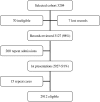ICD-10 codes are a valid tool for identification of pneumonia in hospitalized patients aged > or = 65 years
- PMID: 17445319
- PMCID: PMC2870806
- DOI: 10.1017/S0950268807008564
ICD-10 codes are a valid tool for identification of pneumonia in hospitalized patients aged > or = 65 years
Abstract
This study examines the validity of using ICD-10 codes to identify hospitalized pneumonia cases. Using a case-cohort design, subjects were randomly selected from monthly cohorts of patients aged > or = 65 years discharged from April 2000 to March 2002 from two large tertiary Australian hospitals. Cases had ICD-10-AM codes J10-J18 (pneumonia); the cohort sample was randomly selected from all discharges, frequency matched to cases by month. Codes were validated against three comparators: medical record notation of pneumonia, chest radiograph (CXR) report and both. Notation of pneumonia was determined for 5098/5101 eligible patients, and CXR reports reviewed for 3349/3464 (97%) patients with a CXR. Coding performed best against notation of pneumonia: kappa 0.95, sensitivity 97.8% (95% CI 97.1-98.3), specificity 96.9% (95% CI 96.2-97.5), positive predictive value (PPV) 96.2% (95% CI 95.4-97.0) and negative predictive value (NPV) 98.2% (95% CI 97.6-98.6). When medical record notation of pneumonia is used as the standard, ICD-10 codes are a valid method for retrospective ascertainment of hospitalized pneumonia cases and appear superior to use of complexes of symptoms and signs, or radiology reports.
Figures
Similar articles
-
Hospitalized community-acquired pneumonia in the elderly: an Australian case-cohort study.Epidemiol Infect. 2009 Feb;137(2):194-202. doi: 10.1017/S0950268808000812. Epub 2008 Jun 18. Epidemiol Infect. 2009. PMID: 18559126
-
Accuracy of International classification of diseases, 10th revision codes for identifying severe sepsis in patients admitted from the emergency department.Crit Care Resusc. 2012 Jun;14(2):112-8. Crit Care Resusc. 2012. PMID: 22697618
-
Accuracy of coding for possible warfarin complications in hospital discharge abstracts.Thromb Res. 2006;118(2):253-62. doi: 10.1016/j.thromres.2005.06.015. Epub 2005 Aug 2. Thromb Res. 2006. PMID: 16081144
-
How accurate is ICD coding for epilepsy?Epilepsia. 2010 Jan;51(1):62-9. doi: 10.1111/j.1528-1167.2009.02201.x. Epub 2009 Jul 20. Epilepsia. 2010. PMID: 19682027
-
Administrative data have high variation in validity for recording heart failure.Can J Cardiol. 2010 Oct;26(8):306-12. doi: 10.1016/s0828-282x(10)70438-4. Can J Cardiol. 2010. PMID: 20931099 Free PMC article. Review.
Cited by
-
Validation of an administrative claims-based diagnostic code for pneumonia in a US-based commercially insured COPD population.Int J Chron Obstruct Pulmon Dis. 2015 Jul 23;10:1417-25. doi: 10.2147/COPD.S83135. eCollection 2015. Int J Chron Obstruct Pulmon Dis. 2015. PMID: 26229461 Free PMC article.
-
Identifying pediatric community-acquired pneumonia hospitalizations: Accuracy of administrative billing codes.JAMA Pediatr. 2013 Sep;167(9):851-8. doi: 10.1001/jamapediatrics.2013.186. JAMA Pediatr. 2013. PMID: 23896966 Free PMC article.
-
Using the electronic medical record to identify community-acquired pneumonia: toward a replicable automated strategy.PLoS One. 2013 Aug 13;8(8):e70944. doi: 10.1371/journal.pone.0070944. eCollection 2013. PLoS One. 2013. PMID: 23967138 Free PMC article.
-
Best Practices for Identifying Hospitalized Lower Respiratory Tract Infections Using Administrative Data: A Systematic Literature Review of Validation Studies.Infect Dis Ther. 2024 Apr;13(4):921-940. doi: 10.1007/s40121-024-00949-8. Epub 2024 Mar 18. Infect Dis Ther. 2024. PMID: 38498108 Free PMC article. Review.
-
Tropical Australian Health-Data Linkage Shows Excess Mortality Following Severe Infectious Disease Is Present in the Short-Term and Long-Term after Hospital Discharge.Healthcare (Basel). 2021 Jul 15;9(7):901. doi: 10.3390/healthcare9070901. Healthcare (Basel). 2021. PMID: 34356279 Free PMC article.
References
-
- Smith PR. What diagnostic tests are needed for community-acquired pneumonia? Medical Clinics of North America. 2001;85:1381–1396. - PubMed
-
- Fine MJ, Chowdhry T, Ketema A. Outpatient management of community-acquired pneumonia. Hospital Practice (Office Edition) 1998;33:123–133. - PubMed
-
- Metlay JP et al. Influence of age on symptoms at presentation in patients with community-acquired pneumonia. Archives of Internal Medicine. 1997;157:1453–1459. - PubMed
-
- Marrie TJ et al. Community-acquired pneumonia requiring hospitalization. Is it different in the elderly? Journal of the American Geriatrics Society. 1985;33:671–680. - PubMed
-
- Albaum MN et al. Interobserver reliability of the chest radiograph in community-acquired pneumonia. PORT Investigators. Chest. 1996;110:343–350. - PubMed
Publication types
MeSH terms
LinkOut - more resources
Full Text Sources
Medical
Miscellaneous



